 您的购物车当前为空
您的购物车当前为空
Anti-SUMO1 Antibody (3N929)
一键复制产品信息产品编号 TMAC-03914
别名 UBL1, UBL 1, Ubiquitin like protein UBL1, Ubiquitin like protein SMT3C, Ubiquitin Like 1, Ubiquitin homology domain protein PIC1, SUMO-1, SMT3H3, Smt3C, SMT3 suppressor of mif two 3 homolog 1, SMT3 homolog 3, SMT3, Small ubiquitin-like modifier 1, Small ubiquitin related modifier 1, Sentrin 1, Sentrin, SENP2, PIC1, PIC 1, OFC10, GMP1, GMP 1, GAP modifying protein 1, DAP1
Anti-SUMO1 Antibody (3N929) 是一种 Rabbit 抗体,靶向 SUMO1。Anti-SUMO1 Antibody (3N929) 可用于 ChIP,FCM,ICC/IF,IHC,IP,WB。
Anti-SUMO1 Antibody (3N929)
Anti-SUMO1 Antibody (3N929)
一键复制产品信息产品编号 TMAC-03914 别名 UBL1, UBL 1, Ubiquitin like protein UBL1, Ubiquitin like protein SMT3C, Ubiquitin Like 1, Ubiquitin homology domain protein PIC1, SUMO-1, SMT3H3, Smt3C, SMT3 suppressor of mif two 3 homolog 1, SMT3 homolog 3, SMT3, Small ubiquitin-like modifier 1, Small ubiquitin related modifier 1, Sentrin 1, Sentrin, SENP2, PIC1, PIC 1, OFC10, GMP1, GMP 1, GAP modifying protein 1, DAP1
Anti-SUMO1 Antibody (3N929) 是一种 Rabbit 抗体,靶向 SUMO1。Anti-SUMO1 Antibody (3N929) 可用于 ChIP,FCM,ICC/IF,IHC,IP,WB。
| 规格 | 价格 | 库存 | 数量 |
|---|---|---|---|
| 50 μL | ¥ 1,485 | 5日内发货 | |
| 100 μL | ¥ 2,485 | 5日内发货 |
大包装 & 定制
加入购物车
TargetMol 的所有产品仅用作科学研究或药证申报,不能被用于人体,我们不向个人提供产品和服务。请您遵守承诺用途,不得违反法律法规规定用于任何其他用途。
联系我们获取更多批次信息
资源下载
产品介绍
生物活性
偶联与修饰
抗原信息
化学信息
| 产品描述 | Anti-SUMO1 Antibody (3N929) is a Rabbit antibody targeting SUMO1. Anti-SUMO1 Antibody (3N929) can be used in ChIP,FCM,ICC/IF,IHC,IP,WB. |
| 别名 | UBL1, UBL 1, Ubiquitin like protein UBL1, Ubiquitin like protein SMT3C, Ubiquitin Like 1, Ubiquitin homology domain protein PIC1, SUMO-1, SMT3H3, Smt3C, SMT3 suppressor of mif two 3 homolog 1, SMT3 homolog 3, SMT3, Small ubiquitin-like modifier 1, Small ubiquitin related modifier 1, Sentrin 1, Sentrin, SENP2, PIC1, PIC 1, OFC10, GMP1, GMP 1, GAP modifying protein 1, DAP1 |
| Ig Type | IgG |
| 克隆号 | 3N929 |
| 交叉反应 | Human,Mouse,Rat |
| 验证活性 | 1. Western blot analysis of SUMO-1 on Hela cell lysates using anti-SUMO-1 antibody at 1/1,000 dilution. 2. Immunohistochemical analysis of paraffin-embedded human tonsil tissue using anti-SUMO-1 antibody. Counter stained with hematoxylin. 3. Immunohistochemical analysis of paraffin-embedded human thyroid tissue using anti-SUMO-1 antibody. Counter stained with hematoxylin. 4. Immunohistochemical analysis of paraffin-embedded human breast carcinoma tissue using anti-SUMO-1 antibody. Counter stained with hematoxylin. 5. Immunohistochemical analysis of paraffin-embedded mouse thyroid tissue using anti-SUMO-1 antibody. Counter stained with hematoxylin. 6. Immunohistochemical analysis of paraffin-embedded mouse placenta tissue using anti-SUMO-1 antibody. Counter stained with hematoxylin. 7. ICC staining SUMO-1 in Hela cells (green). The nuclear counter stain is DAPI (blue). Cells were fixed in paraformaldehyde, permeabilised with 0.25% Triton X100/PBS. 8. ICC staining SUMO-1 in A549 cells (green). The nuclear counter stain is DAPI (blue). Cells were fixed in paraformaldehyde, permeabilised with 0.25% Triton X100/PBS. 9. ICC staining SUMO-1 in MCF-7 cells (green). The nuclear counter stain is DAPI (blue). Cells were fixed in paraformaldehyde, permeabilised with 0.25% Triton X100/PBS. 10. Flow cytometric analysis of Hela cells with SUMO-1 antibody at 1/50 dilution (blue) compared with an unlabelled control (cells without incubation with primary antibody; red). Alexa Fluor 488-conjugated goat anti rabbit IgG was used as the secondary antibody.    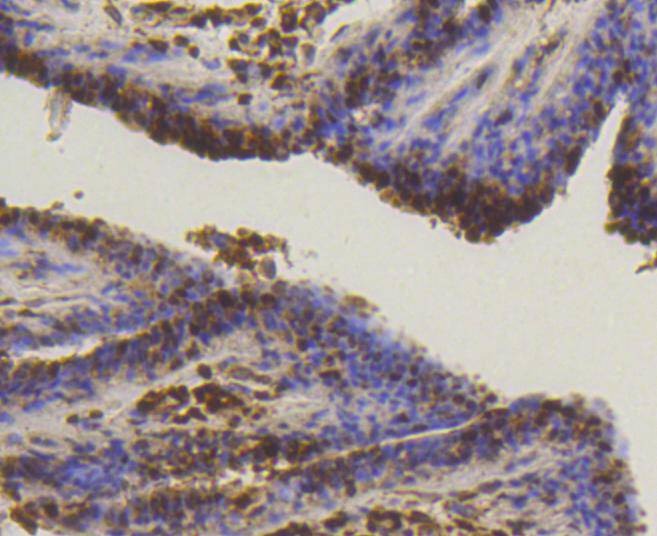 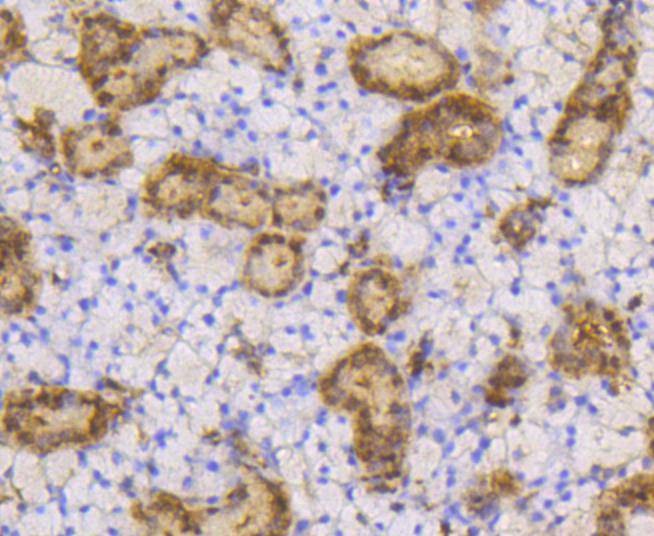 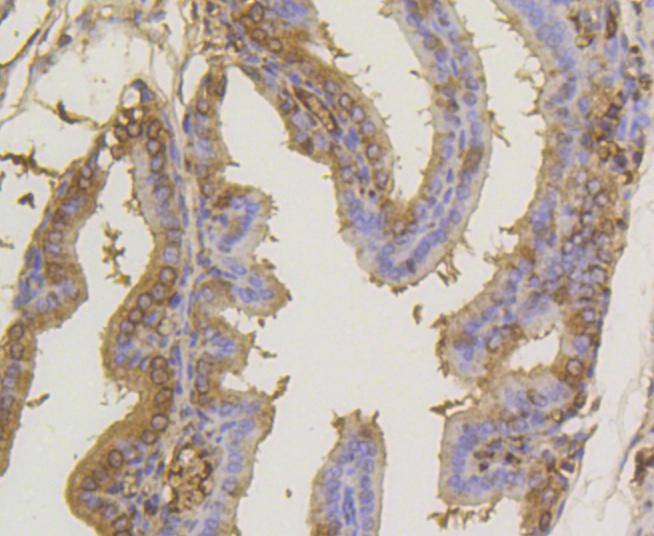 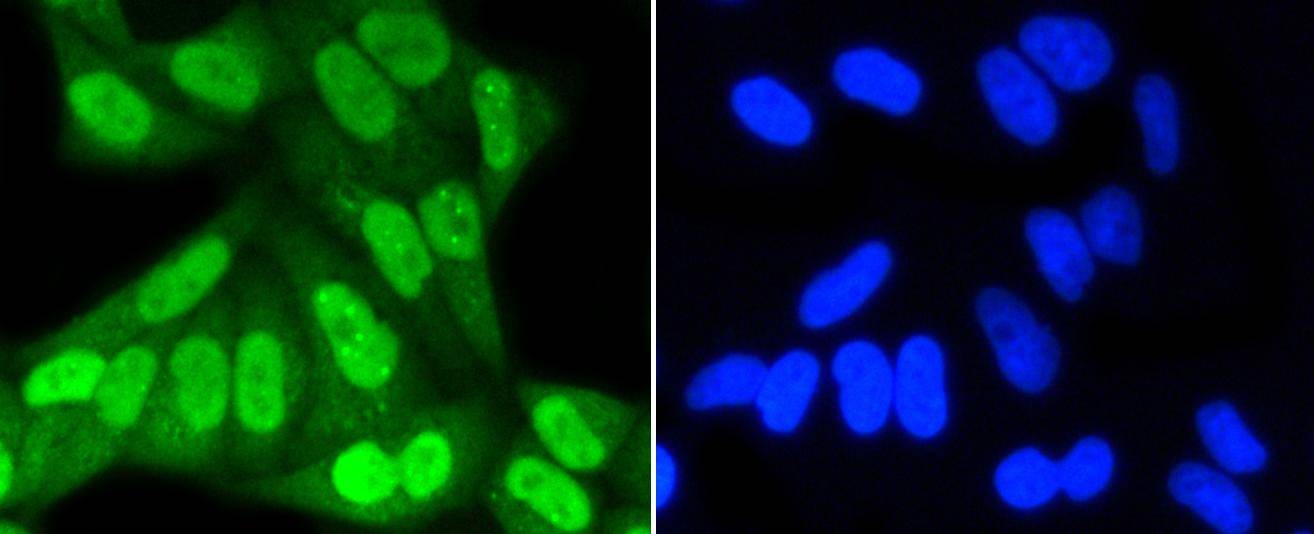 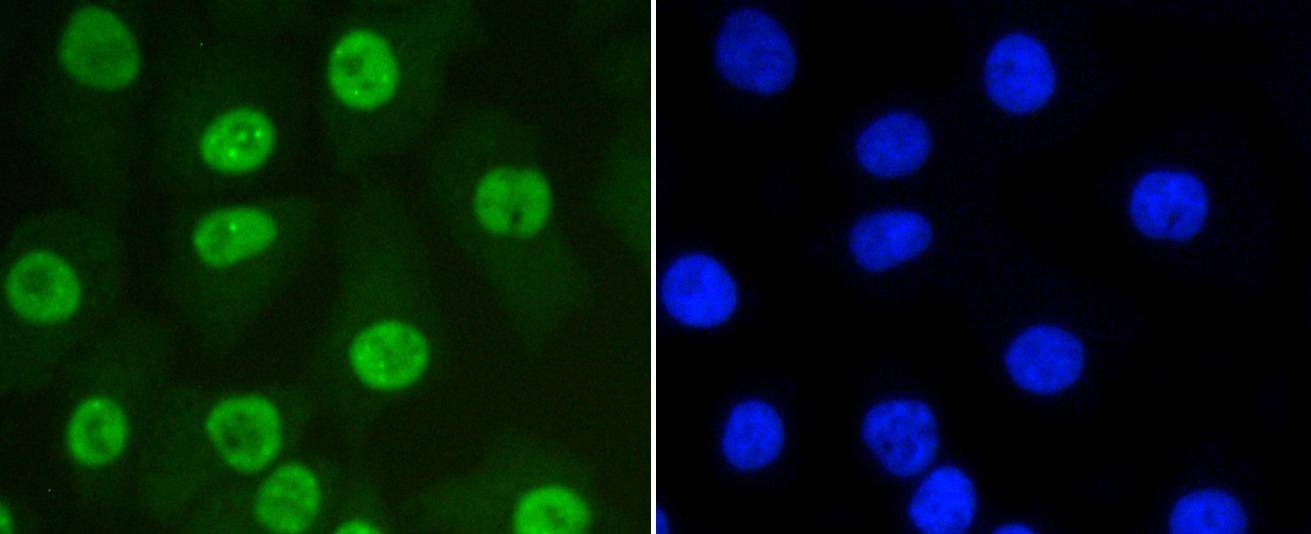 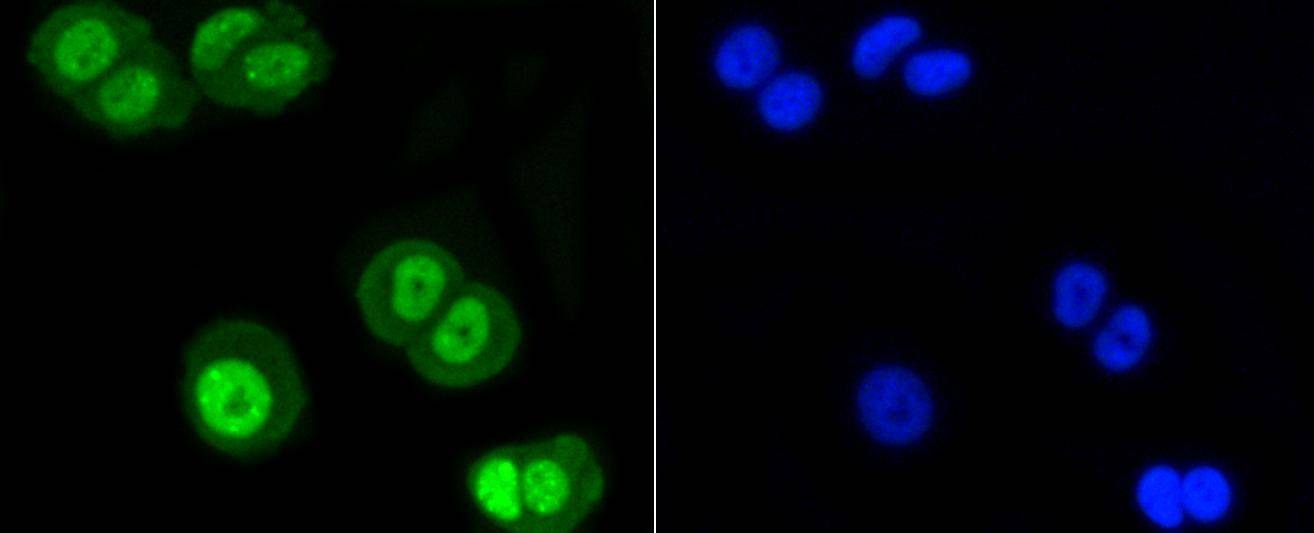 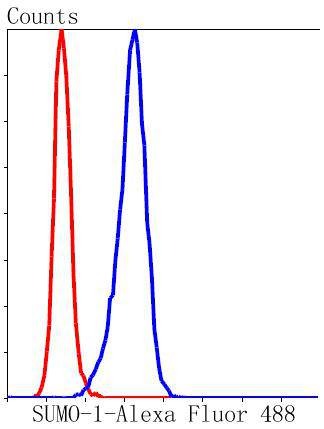 |
| 应用 | ChIPFCMICC/IFIHCIPWB |
| 推荐剂量 | WB: 1:1000-2000; IHC: 1:50-200; ICC/IF: 1:50-200; FCM: 1:50-100 |
| 抗体种类 | Monoclonal |
| 宿主来源 | Rabbit |
| 构建方式 | Recombinant Antibody |
| 纯化方式 | ProA affinity purified |
| 性状 | Liquid |
| 缓冲液 | 1*TBS (pH7.4), 1%BSA, 40%Glycerol. Preservative: 0.05% Sodium Azide. |
| 研究背景 | The small ubiquitin-related modifier (SUMO) proteins, which include SUMO-1, SUMO-2 and SUMO-3, belong to the ubiquitin-like protein family. Like ubiquitin, the SUMO proteins are synthesized as precursor proteins that undergo processing before conjugation to target proteins. Also, both utilize the E1, E2, and E3 cascade enzymes for conjugation. However, SUMO and ubiquitin differ with respect to targeting. Ubiquitination predominantly targets proteins for degradation, whereas sumoylation targets proteins to a variety of cellular processing, including nuclear transport, transcriptional regulation, apoptosis and protein stability. The unconjugated SUMO-1, SUMO-2 and SUMO-3 proteins localize to the nuclear membrane, nuclear bodies and cytoplasm, respectively. SUMO-1 utilizes Ubc9 for conjugation to several target proteins, which include IkBa, MDM2, p53, PML and Ran GAP1. SUMO-2 and SUMO-3 contribute to a greater percentage of protein modification than does SUMO-1, and unlike SUMO-1, they can form polymeric chains. In addition, SUMO-3 regulates b-Amyloid generation and may be critical in the onset or progression of Alzheimer??s disease. |
| 偶联 | Unconjugated |
| 免疫原 | Recombinant Protein |
| Uniprot ID |
| 分子量 | Theoretical: 12 kDa. |
存储&运输
| 储存方式 | Store at -20°C or -80°C for 12 months. Avoid repeated freeze-thaw cycles. |
| 运输方式 | Shipping with blue ice. |
计算器
引用文献
评论列表
Related Tags: buy Anti-SUMO1 Antibody (3N929) | purchase Anti-SUMO1 Antibody (3N929) | Anti-SUMO1 Antibody (3N929) cost | order Anti-SUMO1 Antibody (3N929) | Anti-SUMO1 Antibody (3N929) molecular weight





 还可以
还可以

 |
|
评论内容